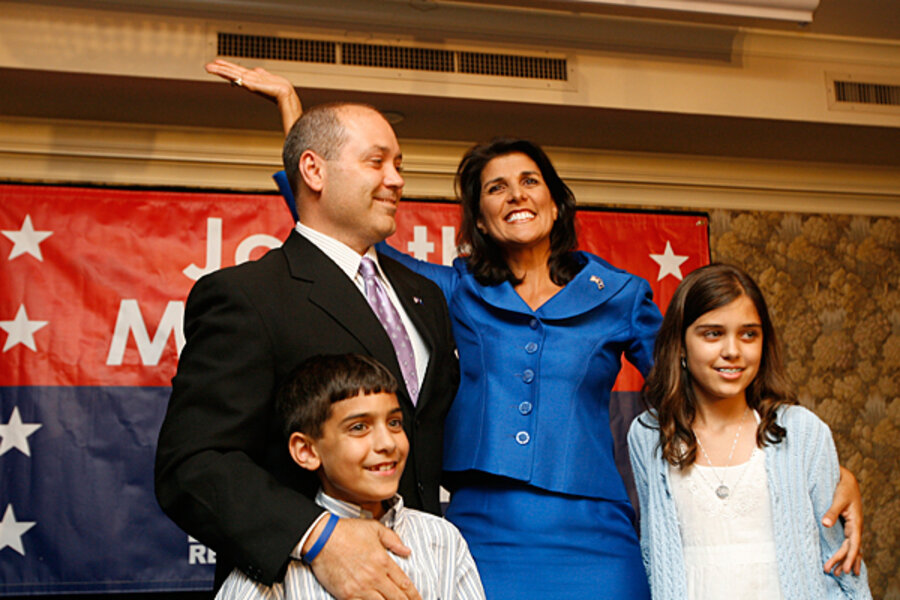The rise of the Indian-American candidate, as Nikki Haley and others run
Loading...
Since Tuesday’s primaries, much has been said about the boost for Republican women candidates. But another group got a lift as well: Indian-Americans.
With Nikki Haley advancing to a GOP runoff in South Carolina’s gubernatorial race, the spotlight is on those of Indian descent and their increased involvement in US politics.
Ms. Haley – born Nimrata Randhawa – is expected to clear the runoff and gain the Republican Party nomination. In right-leaning South Carolina, she stands a good chance of winning in the fall and becoming the second Indian-American governor, after Louisiana Gov. Bobby Jindal (R).
Haley is one of a record number of Indian-Americans in pursuit of a political office this year. Six Indian-Americans are running for Congress in hopes of filling the void that was created after Mr. Jindal, the only Indian congressman, left the House in 2008.
This is the most number of viable Indian candidates running for Congress ever, says David Wasserman, political analyst for The Cook Political Report.
“It’s a positive sign. Very competitive candidates are running, and even if they don't win, they'll be on the map,” he says.
Jindal was only the second Indian congressman. He was elected 42 years after the first Indian congressman, Dalip Singh Saund, left the House.
Now, Surya Yalamanchili, in Ohio, and Manan Trivedi, in Pennsylvania, have received the Democratic nomination for their congressional districts. The other four Indian candidates – all Democrats – still have to go through the primary process, where they will have tough competition: Raj Goyle in Kansas, Ami Bera in California, Ravi Sangisetty in Louisiana, and Reshma Saujani in New York.
"This is a sign of growth for the community in the political realm," says Bhavna Pandit, a Democratic fundraiser in Washington, D.C. "The Indian community is such a big part of the country, and we don't have anyone in Congress."
Surveys have shown that Southeast Asians, which include Indians, politically align more with the left than the right, says Madhulika Khandelwal, director of the Asian/American Center at Queens College in New York. But two of the most successful Indian-American politicians – Jindal and Haley – are Republicans receiving support from two conservative states.
Indians, both Democrat and Republican, are becoming more politically involved at all levels by running for local and state offices, ranging from school boards to state legislatures, Ms. Pandit says.
Although Jindal’s success could have given other Indian-Americans an impetus, she attributes the recent activism to the evolution of the community, which now numbers 2.5 million.
Indians, she says, started becoming politically active in the 1990s. Prior to that, most Indians were first-generation immigrants, who were more focused on establishing themselves in foreign country. But now, second-generation immigrants, who do not have the same anxieties as their parents, have the luxury of spending the time and money that are needed to run for office.
Indians first started becoming involved in politics mainly through fundraising, Ms. Khandelwal says. That was a noteworthy development, she says, because most communities start off through grass-roots mobilization and not through financial contributions.
US India Political Action Committee (USINPAC) is a bipartisan group based in the Washington, D.C., area that provides support for Indian candidates. It’s played a big role in recent years in encouraging Indians to run for local, state, and federal offices.
The organization puts candidates in contact with big donors in the Indian community and helps them plan fundraisers and events, says Sanjay Puri, chairman of USINPAC.
Political financial contributions made by the community have steadily increased in the past two decades. And now, Indians are contributing to candidates of all origins, not just their own, Pandit says.
The Indian-American community is more affluent than some other immigrant groups. In 2007, the US Census Bureau found, the median income of Indian-American families was $69,470 – well above the median income of all American families.
According to Mr. Puri, the election of Jindal was a defining moment for Indians, and since then, his organization has seen a dramatic increase in Indians wanting to become more politically active.
The financial support from the community, along with its desire to see Indian representation in Congress, will intensify the trend of Indians becoming more politically active, Pandit says.
"As each election cycle goes on, we'll have more and more Indian-Americans running for office," she says.
For the Indian candidates currently running for Congress, their biggest hurdle may not be their ethnicity, but rather their Democratic Party affiliation. Many constituents are dissatisfied with the Democratic administration, notes Mr. Wasserman of The Cook Political Report.
“I don't think their ethnicity will become an issue in any of the elections,” he says. “Bobby Jindal's election is proof that even in the Deep South, Indian-American candidates can prove themselves to voters.”
Related:





